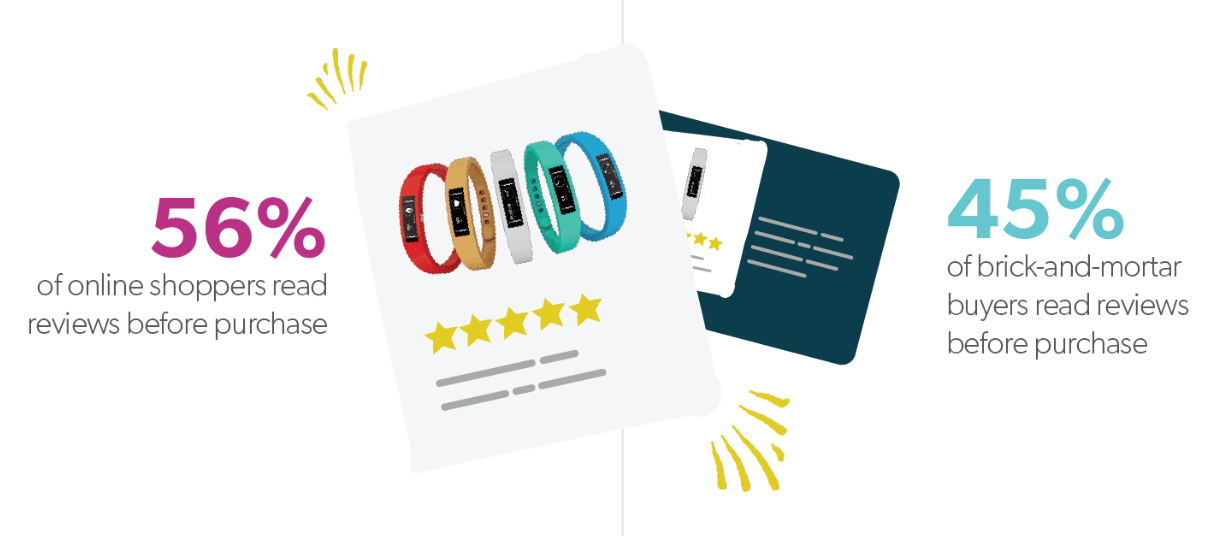
We know that 88% of shoppers rely on ratings and reviews to discover products, but how do you gather reviews if you don’t have an online store? With an offline marketing strategy.
We often hear this from fast-moving consumer goods (FMCG) brands struggling to increase brand awareness and gather feedback. It may not sound like the biggest issue, but your potential shoppers are looking for reviews both on the digital and physical shelf.
The good news is, digital collection isn’t the only way to gather user-generated content (UGC). Sometimes, you simply have to go straight to the source and engage your consumer where they shop.
What is offline marketing?
Offline marketing is any form of marketing that doesn’t take place online. (You don’t say!). Offline marketing examples include billboards, press releases, newspaper and magazine ads, TV commercials, and flyers, to name a few.
While online/digital marketing is essential for staying competitive, combining it with an offline marketing strategy is how you stay most competitive.
Offline marketing strategies for collecting content
One lesser known benefit of offline marketing though is the ability to collect content. Specifically, the kind of content that turns browsers into buyers.
But as with approaching any new strategy, it can be difficult to know where to start with offline marketing. That’s why we’re going to look at how one brand, Hardys Wines, has already achieved offline marketing success.
Hardys Wines paired an offline marketing campaign to gather valuable ratings and reviews with retail syndication to boost review volume, increase brand awareness on retail websites, and enhance social media advertising. Here’s how.
1. An in-store campaign to gather reviews
To address the challenge of being a non-transactional company, Hardys decided to test an alternative UGC collection method: an in-store review campaign. Partnering with their Shopper Agency F&BM and online lesson provider Learning with Experts, Hardys launched a “gift with purchase” campaign across major U.K retailers like Tesco, Asda, and Sainsbury’s, using 15 of its best-selling products to draw shoppers in.
The wine bottles featured neck flags that encouraged customers to purchase the product, leave a review, and register for a free course via a microsite. Learning with Experts offered shoppers exciting courses on photography, French cuisine, container gardening, and more. And customers loved it.
Throughout this offline marketing campaign, the website received over 2,500 entries with over 1,100 courses claimed.
Non-direct-to-consumer (non-DTC) brands often struggle to generate reviews because they lack the online space to collect and display UGC. But reviews are a key factor in conversions. Customers are 2x more likely to purchase a product if it has reviews, and product pages with reviews see a 354% increase in conversion rates.
“We’re looking at social channels, growing the brand, and making sure that Hardys maintains its position as the number one brand in the U.K using the sort of reviews that we’ve captured, ensuring that Hardys is at top of the mind for consumers,” said Alister Dell, Digital Marketing Manager at Hardys.
For Hardys, the offline marketing campaign resulted in over 1,700 reviews, a monumental number for a brand without an e-commerce store. The next challenge was displaying these reviews where consumers could read and interact with them, and the solution came in the form of syndication.
2. Boost review volume with syndication
The decision to syndicate review content across retailer websites helped Hardys increase review volume and boost product ratings. Since non-DTC brands lack the digital space for ratings and reviews, ensuring partner retail websites offer a large volume of reviews is essential.
Content syndication gathers reviews from every source and distributes them across major retail websites, creating a sizable collection for shoppers to browse. For Hardys, syndication resulted in a 2,316% lift in review volume across retailers’ sites, most notably Asda, Tesco, and Sainsbury’s.
Without syndication, numerous products would show zero reviews, creating a risk of revenue loss.
Review syndication also led to an overall increase in product ratings across Hardys Wines’ three major retailers. Because ratings were based on a higher volume of reviews, Hardys product ratings went up from 4.32 to 4.59 stars.
Higher product ratings have major benefits for brands, from increased consumer trust to more prominent store search result placements.
3. Improve marketing efficiency with UGC
UGC is a powerful tool, with 74% of consumers surveyed by Bazaarvoice agreeing that other shoppers’ photos increase their willingness to purchase a product. Knowing the value of UGC, Hardys chose to integrate it within their paid ads on social media and benefited from increased engagement and cost-per-click savings.
Before launching the in-store campaign, Hardys used promotional images throughout their social media pages to build up interest and engagement. The images advertised various classes that shoppers could enroll in once they submitted their review.
Once reviews were gathered, Hardys included UGC from the offline marketing campaign throughout its paid social media ads. This wasn’t a tactic that Hardys had previously used and the brand saw an incredible boost in audience engagement. With a modest budget, the social media campaign led to over 10,000 clicks to retailers’ websites.
“We’ve captured a lot of reviews that we can use in our marketing collateral and we’re really pleased to report that it has led to an increase in advertising effectiveness in the form of better cost per clicks and more engagement,” said Dell.
Although savings weren’t an original priority, increased engagement also led to a cost-per-click decrease of 60%. This freed up a significant chunk of the ad budget that Hardys could allocate to other paid marketing efforts.
Offline UGC collection: A strong marketing strategy for brands
Most brands, especially FMCG brands often have to get creative with their UGC collection methods. In-store promotions, sampling campaigns, influencer partnerships, and microsite content are excellent sources of valuable UGC.
Learn more about Hardys’ take on offline UGC collection, and how it impacted their review volume, marketing efficiencies, and impact at retail in the full case study.
Or continue reading to learn more ways to collect content that converts.





